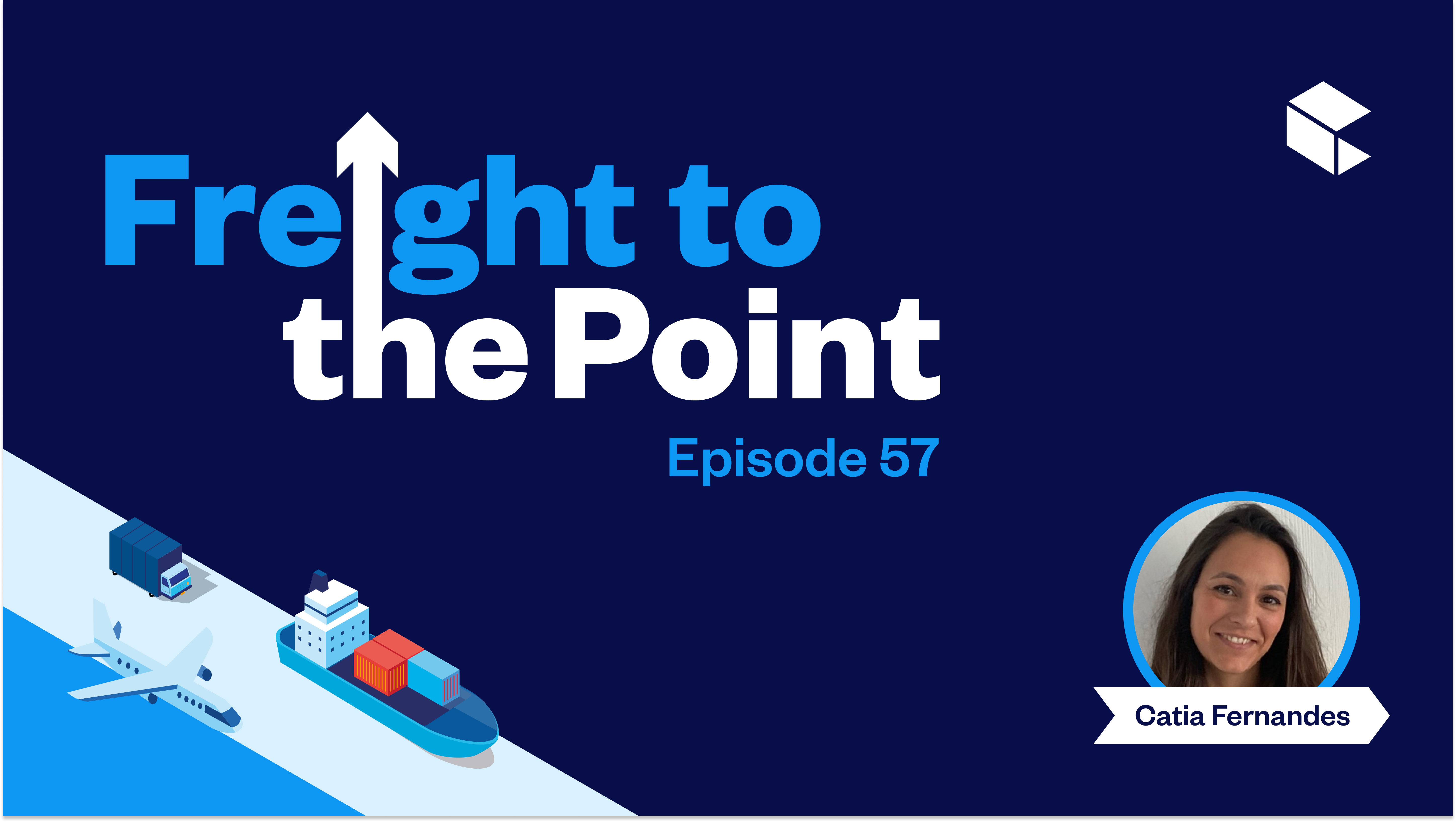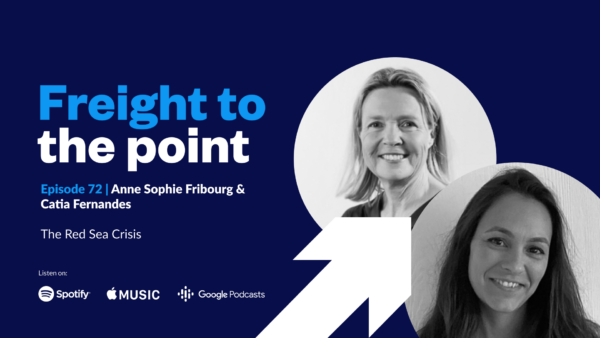Episode 57:
What lessons can we learn from H2
See all episodes

How has schedule reliability improved over the past year? What will happen to the market after the 2M split?
These are some of the questions we’ve answered in our most recent episode of Freight to the Point.
In this episode, we take a deep dive into the current state of the ocean market and the challenges faced by the supply chain industry. As we reach the halfway point of the year, our guest, Catia Fernandes, Head of Ocean Trade Lanes at Zencargo, shares her insights and expertise.
We discuss:
- the evolving nature of the market
- blank sailings
- industrial action
- the dilemma of long-term rate locking
Catia provides valuable perspectives and observations, shedding light on what we can learn from the ocean market in 2023 so far. Join us for this insightful conversation with an industry expert.
Catia Fernandes
Catia Fernandes is the Head of Ocean Trade Lanes at Zencargo. Since starting at Maersk in 2005, Catia has worked in the supply chain space for over 15 years. At Zencargo, Catia is part of the pricing and procurement team, who develop relationships with carriers to help customers find the best rates and space for their shipments.
Resources
Alfie:
Hello, and welcome to another episode of Freight to the Point. I’m Alfie, and I’ll be your podcast host for today. We are already halfway through the year and the market, specifically the auction market has been anything but boring. Although we’ve passed the Covid disruptions, the challenges in the supply chain industry are constantly evolving.
Blank sailings, industrial actions and questions about whether to lock into long term rates, are all common conversations that we’ve all had with our customers, and I’m sure you’re having with your transfer providers as well. So what can we learn from the ocean market this year? I’m joined by Katya, who is our head of Ocean Trade Lands at Zencargo, who will be discussing this topic for today. Hi, Katya.
Katya:
Hello.
Alfie:
Can you give us a bit of background about yourself before we start?
Katya:
Yeah, of course. So I’m Katya, I work in the ocean procurement team, and I’m heading specifically the trades that involve Asia, Europe, in to subcontinent Europe, and intra-Europe. It’s all to do with Europe, it seems.
Alfie:
Everything seems Europe now, yeah?
Katya:
Yeah.
Alfie:
Good. Well, thank you. Well that starts off with 2023. I mean, we’re nearly halfway through now, so there’s a lot going on. So let’s start with the carrier side. What changes have you seen in terms of carriers? What they’ve done is worth mentioning to the audiences today?
Katya:
Yeah, so I would point out four main changes or news, let’s say, that we’ve seen across 2023. I think one of them has been the quite strong blank sailings program that carriers have been implementing. Another, well, obvious, trend we’ve seen is the rates decreasing across all trades in general.
The third big news that we’ve watched is the one about the splitting of the 2M alliance. So Maersk and MSC deciding to go their own ways by 2025. And finally, I can point out the continuous strikes and industrial actions we’ve seen across multiple industries, from ports, to rail operators, customs, which obviously has had impacts.
Alfie:
Wow, that’s a lot of changes, Katya, that happened in just six months, right? Okay. So how do you think this impacted the shippers? And I really want to start with possibly blank sailings as number one, because this is kind of a common thing, and it happens all the time. And also schedule reliability, interesting to know what, what’s going on with it right now, and how that impacted the customers.
Katya:
Yeah. So, blank sailings have obviously impacted shippers. They, first of all, decreased the number of options a shipper has access to when they’re trying to load. And the behavior of implementing last minute blank sailings obviously increases lead times to shippers, and that has an impact on their cost.
However, on a positive note, these blank sailings together with the low demand, have in a way influenced positively the schedule of reliability. We are seeing now a global schedule of reliability based on the latest information. That is about 65%. No, that’s 30% above year on year, which as you can see, it’s a massive improvement. Still far from the pre-Covid times of 85, 90%, but a massive improvement as you can see.
Alfie:
These were the good old days, definitely.
Katya:
Yeah, yeah.
Alfie:
So it is interesting to see that. But then, how will the 2M alliance impact the schedule reliability or capacity in general in the near future? Do you see any change?
Katya:
So right in the near future, shippers shouldn’t see a major impact. I mean, there will be some possible new services coming here and there. You have the example of the Swan service that has just been introduced as a standalone service from MSC. But you won’t see a massive impact across this year, or even in possibly the beginning of 2024.
If you’re talking more around the deadline of the end of the alliance in 2025, then we might see changes at that point, with new partnerships being done between carriers, which might affect them the way services are offered. But right now we can’t see a major impact that shippers will see obviously around that.
Alfie:
Okay. So will that impact rates as well? I think lots of listeners are really keen to understand how the rate structure, or the rate strategies, are going. And obviously everyone’s seen a big drop since 2022, and it was really, really going down. But where are we really now with rates?
Katya:
So generally, across all trades rates have been coming down. Obviously, there’s differences in each trade. If you talk about the big trades, the Asia, Europe, the TP trade, rates are very low right now. But if you talk about, for example, the transatlantic trade, while rates are decreasing, there’s still a big gap to go until they hit the lowest they can be.
So they differentiate between different trades. There’s different behaviors of how much can it go down. But in general, rates have all suffered a decrease, as you’ve seen. And some of them are basically at the bottom now, from what we believe at least, compared to pre-Covid levels.
Alfie:
Well, that’s good to know, at least for now, in some way or another. But we still have the industrial actions. And how is that impacting supply chain in general? What changes do you think it’s impacting everyone now?
Katya:
Yeah, so all of the industrial actions we’ve seen, they’ve been affecting either availability of rail, or ability of getting containers in and out of ports, or being able to do customs clearance on time. All of these obviously have an impact on the lead times of cargo, and anything that has an impact on lead times if cargo has an impact on costs or missed revenue.
So they are a consequence of the current economic conditions that we’ve seen across multiple countries, in Europe, in the US, and they are there to stay until that economic situation improves in a way.
Alfie:
Does that impact the demand at all? The whole, what we talked about really, industrial actions rates? Do you see any demand picking up at all, to cover this up?
Katya:
So the factors that impact demand are linked to the economic situation, really. So what we know is that the demand hasn’t picked up as expected. There has been some pockets, but not really a relevant demand increase. The reason for that is because stock levels, for example in the US, stock levels are still high. And inflation is a big element, especially in Europe, and that’s preventing demand to increase.
So until that reverses, there’s not a major in increase in demand. However, some industries are seeing a possibility of restocking, and carriers themselves have indicated they expect a mini peak increase around Q3. So it will happen, but it might not happen to the level that initially was estimated, and it might only really, really happen next year. But there will be a small increase expected still around Q3.
Alfie:
Okay. So we’re seeing now, just to sum up really, demand is not picking up as it should be. Rates are reaching more of a plateau. Obviously, we’ve seen a major change in the carrier front, in terms of the big alliances, assembling, and obviously having industrial actions doesn’t help.
So as much as I’d like to talk about all the issues, I’d like to see how can we manage to overcome these things. So what are the things that customers and shippers really need to put into consideration, and really recommendation of key phrase strategies that they should be aware of to battle these things?
Katya:
Yeah. So understanding where the market is a major component that will help decide what’s the best strategy. And right now, we understand in Zencargo, that in certain trades the market is really low, so locking in longer term deals will help to get that low cost stable for a period. The trade-off between the stock market going down further is not really that big, so there’s not much that it can go down further.
So therefore, the advantage of locking in the rate at this stage means if the rates increase, they won’t be penalized for that, and they will have access to then a more stable space release when the volumes pick up. That also helps the customers in knowing the expected cost level, in planning their stock levels around an expected cost, which means they won’t be having peaks of stock coming in, depending on how rates develop.
Overall, that all impacts customers’ working capital, because of the level of stocks they hold, and the level of costs they have, which shouldn’t go, we believe, shouldn’t be too unstable, if they lock them into longer term deals. However, I think it is really important that customers are, in a way, flexible. Flexible to the way they work, so that they can accommodate the fact that there’s a blank sailing strategies going on still. And so, if they are open to multiple options, then they can receive a continuous service.
And it’s also very important that they work with trusted partners, and partners that can help them provide that continuous service when there’s problems. So have the right contingency plans in place, to avoid any sudden costs or any unexpected costs. I think that those two elements together provide customers the best way to deal with their supply chain, by understanding the level of cost they’re expecting, avoiding sudden increases, and therefore planning ahead, to maximize the levels of stock they need without incurring in extra costs, basically.
Alfie:
That’s great advice. I think there’s a lot of things, takeaways, from this discussion, in terms of battling these things. One of my favorite things you’ve just said now is being flexible. I think it’s very important really at this time, with all these disruptions, and the market is going up and down, and plateauing. It keeps changing still, despite we see a bit of staling there. Flexibility is a key.
But thank you so much, Katya. I think that that was very helpful, and I think that concludes our session. Thank you so much. And thank you everyone for joining us on another episode of Freight To the Point. I’d like to also remind you not to forget to like and subscribe our series on Spotify, Apple Podcasts, or Google Podcasts, if you enjoyed this episode.
And of course, if you have any questions or feedback, please feel free to reach out to us on LinkedIn, or any social media, or email, or give us a call. We’re more than happy to help you. Thank you so much. I would absolutely love to hear from you.

Episode 72: The Red Sea Crisis
In the latest episode of Freight to the Point, we’ve featured our most rec...

Episode 71: The potential of demand forecasting with artificial intelligence
In the most recent instalment of Freight to the Point, Lucie Phillips, Zen...

Episode 70: Rates: What's next for 2024?
As we prepare for the year ahead, it's crucial to consider the three pillars...

